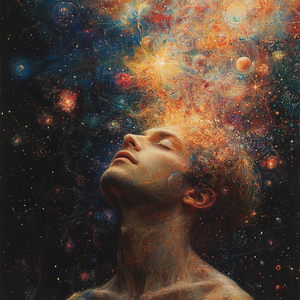Unlocking The Fourth Dimension
How Lucid Dreaming Opens Doorways to Expanded Consciousness
Introduction
The human mind is perhaps the most powerful tool we possess, yet most of us barely scratch the surface of its capabilities. In our quest to understand consciousness and reality, we often overlook one of the most accessible gateways to higher dimensions: our own dream state. Lucid dreaming—the practice of becoming conscious within your dreams—offers not just entertainment but a profound opportunity to explore realms beyond our three-dimensional existence. This exploration can lead to greater awareness, deeper compassion, and a more expansive understanding of our place in the universe.
The Challenge of Lucid Dreaming
Lucid dreaming exists on a spectrum of difficulty, with distinct phases that practitioners must master:
- Becoming conscious within the dream - The initial challenge is simply recognizing you're dreaming while in the dream state.
- Establishing awareness and control - Once conscious, learning to maintain that awareness and gain some control over your environment.
- Intentional exploration - Using that control to direct your experience toward specific goals, such as experiencing higher dimensions.
"The first thing is the most difficult is to become consciously aware of yourself in your dream state, lucid dreaming. The next phase is can you establish a level of awareness, control, familiarity of the environment. Once you've done that and you are conscious, can you then consciously say to yourself in that place, I want to experience the fourth dimension?"
The difficulty lies not just in achieving lucidity but maintaining it without becoming distracted. When we first realize we're dreaming, we often become excited about the possibilities—flying, superpowers, or other fantastical experiences—which can pull us away from deeper exploration.
Transcending Physical Limitations
Our physical bodies impose significant limitations on how we perceive reality. We're designed with forward-facing sensory organs, creating what one might call a "dish parameter" where everything we experience is funneled through a specific, limited perspective:
"Everything is weird. It's like everything is like all my senses for my face are right here... It's like somebody took a potato and stuck all the features in one localized area and nothing not utilizing the rest."
This design prioritizes forward movement and linear thinking, which limits our capacity for multidimensional understanding. In lucid dreams, however, we have the opportunity to experience consciousness without these physical constraints.
Expanding Perception Through Practice
To access expanded states of consciousness, whether in dreams or meditation, we must first recognize that our limitations are often self-imposed. Several practices can help expand our perceptual capabilities:
Visual Expansion Exercises
Begin by imagining what it would be like to perceive beyond your normal visual field:
"Can you close your eyes and imagine what it would be to see in a 180, a 360, a spherical view, or at least a broader spectrum? Let's say you know how to simulate a chair, you can simulate a table and stuff. The next thing is, can you simulate a dog? Can you imagine what it is to perceive from the eyes of the dog?"
These exercises train your brain to conceptualize perception beyond human limitations. By practicing with animals that have different sensory arrangements (like horses with their wide-set eyes), you gradually prepare your mind to accept non-human modes of awareness.
Walking Backwards
Another practical exercise involves walking backwards in a safe, open environment:
"You should try to walk backwards because it forces your sensory to kind of find ways to, how do you know what's behind you? There's a very strong need to say, I don't want to walk into a tree. I don't want to fall over something."
This practice forces your brain to develop alternative sensory awareness out of necessity, activating what might be called your "sixth sense" as a survival mechanism.
Accessing the Fourth Dimension in Dreams
When attempting to access the fourth dimension through lucid dreaming, the primary challenge is that we enter dreams still thinking of ourselves as human beings with human limitations:
"If you're gonna go into fourth dimension, you have to really understand that you'll get pushed right back out because you're going in with unaware, but you're going in with a set rules that you are still thinking as if you're a human being. And in the fourth dimension, it doesn't make any sense there."
To overcome this, you must first redefine your self-concept. Before attempting to access higher dimensions, practice recognizing yourself as consciousness rather than a body:
"I would want to first reflect on myself as to what am I. Am I this organic body? Now it's time to get rid of this, I'm a consciousness."
This mental preparation helps prevent your consciousness from being "pushed out" of higher dimensional experiences because of incompatible frameworks of understanding.
The Meditation Pathway
For those seeking to access expanded states through meditation rather than dreaming, visualization techniques can be extremely powerful:
"Imagine as you listen to the drone that you're starting to elevate higher moving into it until it envelops you. And I want you to just concentrate on the idea that that is the frequency of God or love or the universe."
The key insight is that we're never truly limited to one state of consciousness—we simply choose to believe we are:
"You are never in one place. You just choose to be. The room that you're in is by your choice. The reality of your room is by your choice."
Overcoming Mental Distractions
One of the most common challenges in both meditation and lucid dreaming is dealing with intrusive thoughts. When these occur, the recommended approach is counterintuitive:
"If you wanna be a spiritual master, then love your thought that came into your mind... And imagine you give it a big hug, no matter how ugly, how bad it is. And just accept it and just patiently go back to what you were doing."
Instead of fighting against distractions, practice admirating the incredible detail and complexity your mind can generate:
"When it shows you something in detail and you see the fabric of a sheet with color dyed and every little petal of flowers on there, I sit there and I go, that's amazing, awesome. And I revel in it until it becomes nothing of interest to me no more."
This approach transforms what would normally be frustrating interruptions into opportunities for wonder and appreciation.
The Evolutionary Purpose of Dreams
Dreams serve a fundamental evolutionary purpose in helping us process anxiety, learn from experiences, and adapt to new situations:
"So what do you think they had dreams about for the next month? They had dreams of fire to cope, to learn... And then all of a sudden they overcame their fear of fire because the dream trained them. And then they learned to approach it slowly."
When we no longer need dreams to process specific anxieties or learn particular lessons, those dream themes naturally fade away, allowing consciousness to focus on new areas of growth.
Experiencing Beyond Human Perception
The ultimate benefit of expanded consciousness, whether through dreams or other practices, is access to experiences that transcend ordinary human perception:
"I have seen things that I cannot even begin to explain to you... I could tell you it moved me to tears, it changed me as a human being, it changed me as a spiritual being, it elevated my relationship to the universe."
These experiences create profound shifts in how we relate to existence, often fostering greater compassion, appreciation for life, and spiritual evolution:
"As something evolves, one of the things that happens is that you admire life. Because life is probably one of the most sophisticated things in the whole universe, it's all forms of life."
Conclusion
Lucid dreaming offers more than just entertainment or escape—it provides a laboratory for consciousness exploration that can fundamentally transform how we understand reality. By practicing techniques to expand our perception, treating our dreams as valuable experiences rather than distractions, and approaching the limitations of our consciousness with curiosity rather than frustration, we can begin to access dimensions of experience beyond ordinary awareness.
The journey toward expanded consciousness isn't about rejecting our human experience but enriching it. As we learn to navigate beyond the constraints of our physical form, we develop greater compassion, wonder, and appreciation for the complexity of existence. Perhaps most importantly, we discover that the boundaries we perceive are often self-imposed—and that with practice and intention, we can experience reality in ways that seem impossible from our ordinary perspective.
The fourth dimension isn't somewhere "out there"—it's accessible through the doorway of our own consciousness, waiting to be explored by those willing to question their fundamental assumptions about reality and perception.




Comments